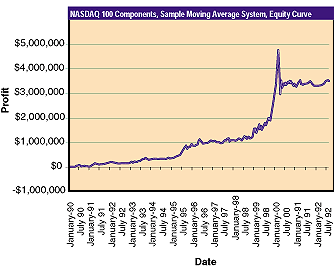SYSTEM DESIGN
Post-Pop Problems
Aftermath Of The Bubble
by Phil Abel
The Internet mania of 1999-2000 caused tremendous price movements in many securities. As you develop and test the long-term viability of new trading models, you must be able to discount the effects of such extraordinary events.
The speculative market bubble of 1999-2000 made and broke many fortunes, sometimes within a day. Stocks that were even remotely connected with the Internet witnessed enormous growth and subsequent markdown of share prices. Companies with no real business models or history could float multibillion-dollar initial public offerings (IPOs) that doubled or tripled in price on their first day of trading.
During the bubble, virtually any trend-following trading system would have captured substantial profits. These days, you must face the reality of trading in a much more cautious market. However, recent price data has been "tainted" with the effects of the Internet bubble. Now, you cannot simply test your new trading models over three or four years of recent data and then assume you will make a mint in the future because the model did extraordinarily well in 1999. You need to test your models with a large and diverse sample of historical data in order to have confidence that your model is indeed sound over a variety of market conditions, and not simply profitable because of one or two big trades during the Internet bubble.
BACKTEST EXAMPLE
To illustrate the effect of the market bubble on a trading model, I analyzed a system using a basket of technology stocks that were greatly affected by the speculative mania. I tested the 100 component members of the Nasdaq 100 (members as of August 2002) from January 1990 through August 2002. Stocks that commenced trading after January 1990 were tested since inception.

FIGURE 1: EQUITY CURVE. Notice the obvious acceleration during the bubble.
...Continued in the April 2003 issue of Technical Analysis of STOCKS & COMMODITIES
Excerpted from an article originally published in the April 2003 issue of Technical Analysis of STOCKS & COMMODITIES magazine. All rights reserved. © Copyright 2003, Technical Analysis, Inc.
Return to April 2003 Contents